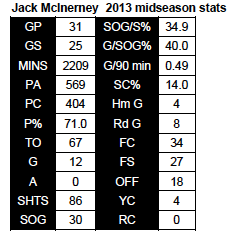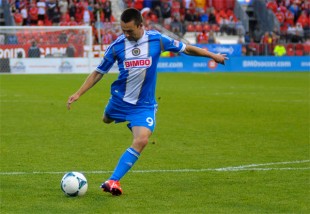Photo: Earl Gardner
Editor’s note: PSP continues its annual tradition of producing season reviews for each Union player. We’ll run one review per weekday between now and Thanksgiving.
No one has summed up Jack McInerney’s season better than the man himself:
It seems like I should be happy. But I think I could have done better. I think I could have scored more. And we’re disappointed we didn’t make the playoffs. So for me, it wasn’t good enough.
Indeed. For a player who scored 10 goals by June 1, going 17 games and more than four months before scoring again has to feel like a failure.
But at only 21 years old, there’s another phrase one might use to describe such a season: growing pains.
Through the first two months of the season, it seemed Jack McInerney could not be stopped. He popped up in all the right places at all the right times to win the Union games or bail them out of losses. (McInerney’s five game-winning goals tied him for second best in MLS, behind only Mike Magee’s six.) His efforts had him leading the MLS scoring charts and earned him a call-up to the U.S. Men’s National Team for the Gold Cup.
Looking back, the impulse might be to label that early-season form as a fluke or a flash in the pan.
But taking a closer look at McInerney’s season stats reveals a different story, that of a young player with the potential to be very, very good, but who, through a combination of inexperience, poor managerial decisions, and a lack of service from his teammates, went through a prolonged dry spell.
It’s certainly the case that McInerney missed goals he “should have” hit, and his confidence was shaken. Any observant Union fan can look back at the game tape and find fluffed opportunities.
But throughout his slump, the larger contributing factors had to do with his positioning on the field and the lack of midfield service. McInerney is a traditional number 9. He thrives when straddling the last line of defense — darting behind slower center backs, racing onto through balls — or using judicious movement to find space inside a crowded penalty box. However, with the lack of a midfield creator behind them, both McInerney and strike partner Conor Casey spent large portions of the season dropping deep into midfield to pick up the ball and try to create chances. While both players have that capacity, neither thrives that way. McInerney was also occasionally shunted out wide in a 4-3-3. This, again, was a mistake, as anything that pulls McInerney away from the center, away from goal, dulls his effectiveness.
The issues with positioning, of course, were driven by the Union’s lack of quality midfield support. The Union’s well-documented struggles to find any semblance of attacking midfield play is the primary reason for the entire team’s struggles in the second half of the season, and no one suffered more than the strikers. As the goals for McInerney and the rest of the team dried up, so did the assists. Without accurate passes and crosses into the area, there was little opportunity for McInerney to score. One can’t convert chances that don’t exist.
Finally, coach John Hackworth’s removal of McInerney from the starting lineup was not successful. McInerney has always performed better as a starter, and getting subbed late in games or coming on as a late-game substitute was not the best way to utilize him, even if he scored his last two games of the season as a sub.
 High point
High point
Surely, the high point of McInerney’s season was getting the call-up to the USMNT. It came after the best span in his career, and was just reward for the way he’d carried the Union through the first three months of the season. While he did not appear for the team during the Gold Cup, all reports are that he showed very well in practice and learned a great deal.
Low point
Missing what seemed an easy header to beat Montreal at PPL Park on August 31. It was perhaps the easiest chance he missed in the entire drought and, had it gone in, might have kickstarted his goal-scoring, cutting six weeks from his slump. Not to mention that the added points might have put the Union in the playoffs.
Strengths
McInerney’s biggest weapon is his movement. Without the ball, he is a menace, constantly putting himself in dangerous positions. McInerney scores lots of tap-ins, which some deem luck, but they are actually the result of a finely tuned positional awareness that puts him in the right place at the right time.
Secondary to his movement, McInerney’s next best skill is finishing. Including his drought, McInerney finished 40 percent of his shots on goal, which puts him at the top of MLS with Golden Boot winner Camilo (who also finishes 40 percent of his shots on goal) and Mike Magee (42 percent). If McInerney puts the ball on frame, it becomes a goal at an elite rate. (The leader for strikers in MLS in converting shots on goal to goals is Robbie Keane, who scored an incredible 55 percent of his shots on goal.)
Weaknesses
Maturity is McInerney’s biggest weakness. Whether it’s his petulant annoyance with teammates when they don’t do as he thinks they should or the composure to put misses behind him, McInerney is still a young player, and it shows. The only prescription for that is time.
On the other side of the shooting coin, the area that McInerney could improve is the percentage of his shots that do hit the target. The top strikers in MLS this season put about 45 percent of their shots on goal. McInerney was only at 35 percent. Obviously, that number is influenced by the slump he went through, and the sample size is relatively small, as McInerney took only 86 shots in 2013.
Outlook
Put bluntly, Jack McInerney is the best striker the Philadelphia Union have, and by some margin. Furthermore, he is close to being one of the best strikers in MLS — full stop. Through June 1, when McInerney scored his tenth goal of the season, his ratio of shots to shots on goal was 42 percent, and his shots on goal to goals ratio was 53 percent. Over the course of a full season, those numbers would easily put McInerney in amongst the top three strikers in MLS, if not at the top.
It’s up to McInerney to prove that the real player is the one from the first three months (and last three games) of 2013, and not the one who went months without a goal. Assuming he is put in a better position to succeed by the coaching staff, McInerney should have no trouble doing just that. His stated target of 20 goals next season seems very reasonable.
It’s unclear, however, if McInerney has the capacity to improve further and find success abroad. He may be more of a Chris Wondolowski, a skilled, opportunistic striker who dominates at MLS level, is a fringe national team player, but fails to rise above that (which, to be fair, is a pretty amazing accomplishment in itself). Luckily, time is on McInerney’s side. Still only 21, McInerney has five years of development to go before he could be said to be in his physical and tactical prime.
Truly, the sky’s the limit.
Stat chart legend:
POS: Position; GP: Games Played; GS: Games Started; MINS: Minutes; PA: Passes Attempted; PC: Passes Completed; P%: Passing Accuracy Percentage; TO: Turnovers (not from incomplete passes); G: Goals; A: Assists; SOG: Shots on Goal; SOG/S%: Percentage of Shots that are on Goal; G/SOG%: Percentage of Shots on Goal Converted; SC%: Scoring Percentage; G/90min: Goals per 90 minutes; Hm G: Home Goals; Rd G: Road Goals; FC: Fouls Committed; FS: Fouls Suffered; YC: Yellow Cards; RC: Red Cards


I don’t know… i’m kinda getting tired of MAC.. really, most of his goals he -should- have scored, the problem is he prob missed way more opportunities… easy… opportunities….
.
And I’m getting tired of the sighing on the field when his teammates don’t set him up -perfectly- for an easy goal..
.
Really, how many goals did MAC actually work to get.. like Casey/Farfan kinda work… unless things are nearly perfect, he doesn’t score…
I have to agree with steve g with this one. It would be nice to see him on the field a whole season without cruz. I was at the seattle game and the two goals he scored right in front of my kids and I were awesome but how many opportunities did cruz kill by his lack of skill
The biggest stat that stands out for me is the goose egg in the assist column. I understand he is a goal-scoring forward, however, when Le Toux scored 14 the first year he also assisted on 11 more. Now i don’t expect Jack to get numbers like that right off the bat, but zero is unacceptable. Jack is a huge talent but he needs to develop into more of a team player in order to fulfill his true potential.
1) If it’s so easy to score goals like Jack Mac does, then why does no one else on our team do it? And why are there so few 10+ goal scorers around the league?
.
2) Jack Mac made some very incisive passes that should have led to goals this year. I agree that he needs to work on this side of his game, but 0 assists doesn’t tell you the whole story.
3) IMO, he needs to work on long distance finishing and contributing to the build up play. He has a great mentor in Casey on the latter. I was amazed by Casey’s footwork and especially his vision. Hopefully, Casey can help Jack take his game to the next level in 2014.
+1
.
I was pleasantly surprised by the Casey/McInerney pairing. Hope they can build upon this year. A better midfield wouldn’t hurt either.
I love Jack’s attitude. He knows he can do better. The silver lining about his goalless streak is that he was still getting into good positions. If he can improve his finishing and mature a little bit, he could have an even better season next year.